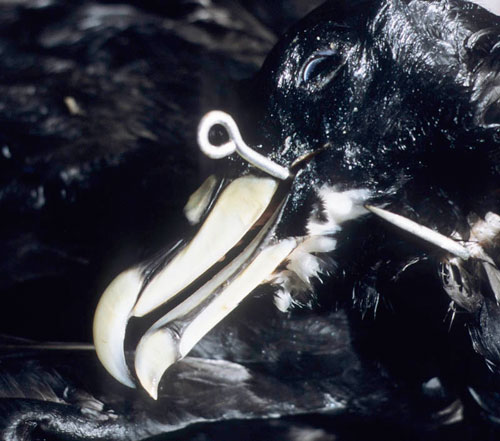Ed Melvin (Washington Sea Grant, University of Washington, Seattle, USA) and colleagues, writing in the journal Fisheries Research, have looked at how to reduce seabird mortality, including of White-chinned Petrels Procellaria aequinoctialis, in a pelagic tuna fishery off South Africa.
The paper’s abstract follows:
“We compared the performance of two bird-scaring line designs (light lines with short streamers vs. hybrid lines with a mix of long and short streamers) deployed in pairs with unweighted branch lines on two joint venture tuna vessels typical of distant-water tuna fisheries in the South Africa Exclusive Economic Zone (EEZ). We also added weight to a subset of branch lines, and compared the effects of line weighting and night vs. day setting in combination with bird-scaring lines on bird and fish catch rates. White-chinned petrels (Procellaria aequinoctialis), a diving seabird, dominated the seabird assemblage; they were the most numerous seabird and they attacked baited hooks and were killed at the highest rates. Secondary attacks – surface foraging albatrosses stealing baits from white-chinned petrels – drove albatross mortality. With hybrid scaring lines deployed, both diving and surface foraging seabirds made fewer attacks (1.5 and 2 times, respectively) within the lines’ 100 m aerial extent, where hooks are closest to the surface and birds are most vulnerable to hooking, than with light lines. However, all metrics of comparison between hybrid and light lines were not statistically conclusive, primarily because birds could access baited hooks in areas beyond the protection afforded by bird-scaring lines (aft and to port of their aerial extent). Seabird bycatch rates were 4.6 times higher during daylight hours (2.00 birds/1000 hooks; 52 birds) than at night (0.439 birds/1000 hooks; 28 birds) and night catch rates near the full moon doubled. Bird catch rates were 18 times higher on unweighted branch lines (1.07/1000 hooks; 79 birds) than on weighted branch lines (0.06/1000 hooks; 1 bird) with no detectable effect on fish catch. With respect to streamer lines, our results suggest that in Procellaria petrel dominated systems the aerial extent of bird-scaring lines (of any design) should span the distance that baited hooks are within 10 m of the surface to effectively prevent bird attacks on baits. Overall, results suggest that night setting, adequate branch line weighting, and proper deployment of two bird-scaring lines have the potential to reduce seabird bycatch in pelagic longline fisheries without reducing the catch rates of target fishes. Further development of safe, fast-sinking branch line weighting configurations and bird-scaring lines less prone to tangling on fishing gear is critical to this effort.”

A White-chinned Petrel drowns on a tuna hook. Photograph by Nicolas Gasco
Reference:
Melvin, E.F., Guy, T.J. & Read, L.B. 2013. Reducing seabird bycatch in the South African joint venture tuna fishery using bird-scaring lines, branch line weighting and nighttime setting of hooks. Fisheries Research 147: 72-82.
With thanks to Barry Baker for information.
John Cooper, ACAP Information Officer, 7 June 2013

 English
English  Français
Français  Español
Español